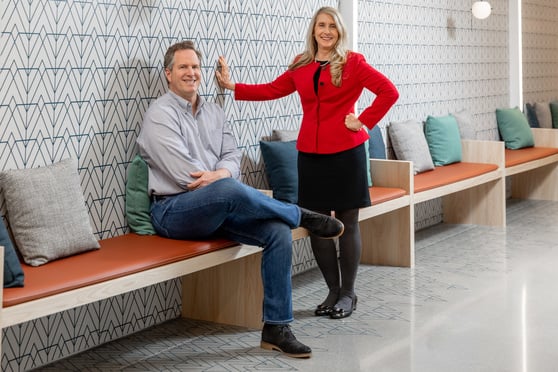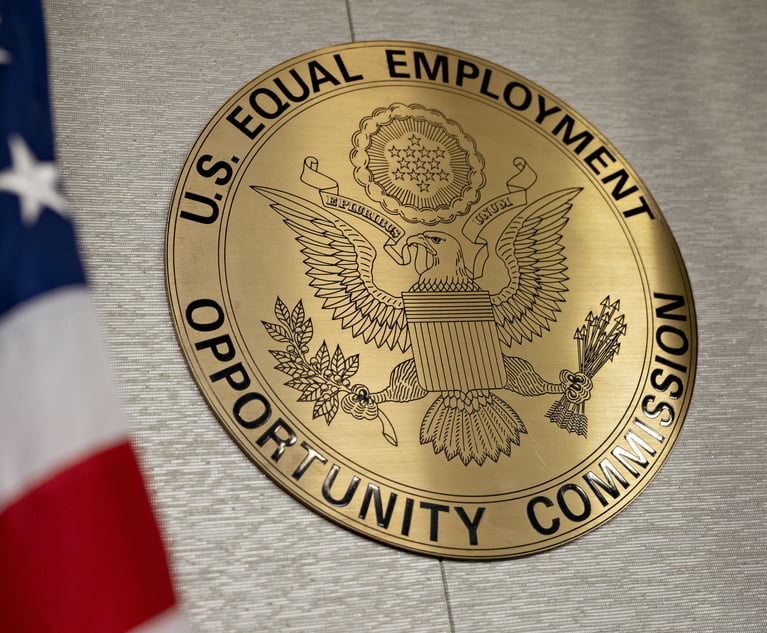NetApp Had a Long Road to the Top of In-house Innovation
NetApp's lawyers are not just committed to improving technology within the legal department--they've spread their tech savvy to other parts of the company (and even outside NetApp) as well.
May 18, 2018 at 11:15 AM
7 minute read
 Matthew Fawcett general counsel and secretary, Connie Brenton chief of staff/director of legal operations
Matthew Fawcett general counsel and secretary, Connie Brenton chief of staff/director of legal operations
“Just start.”
That's Emily Teuben's tech advice for legal teams. And as the senior legal operations manager for Sunnyvale, California-based NetApp, she's seen the power of embracing technology in-house.
“A lot of people in other legal departments are afraid to move forward on something, or think they need to completely map out 100 percent of their process before the move,” Teuben says. “Grab anything. Find something and move on it.”
And move on it, NetApp has. In 2017 alone, the 45-person department used workflow processes to simplify document collection, due diligence and General Data Protection Regulation compliance. It has redesigned the company's legal intranet, created new dashboards and saved the company millions with e-signature solution Adobe Sign.
Not only has NetApp's legal department executed on all these projects, its lawyers have also become early adopters of new technology who help others in the company—and even beyond—innovate and learn. For their accomplishments, Corporate Counsel has named NetApp this year's Best Legal Department for use of technology.
But NetApp wasn't always operating at legal tech's forefront. In 2010, when general counsel Matthew Fawcett joined the storage and data management company, he entered the legal department each day to find three-foot-tall stacks of contracts to be sent off to Amsterdam.
Fawcett noted the excess paper was labor-intensive and expensive. Getting international contracts signed meant at least a week of writing, mailing and waiting for documents from Europe to arrive, delaying revenue that couldn't be collected until the contracts were completed.
“I said, why are we doing that? Why are we not doing this electronically?” he recalls. “And the resistance comes up from a number of places, and it's just usually because it's something nobody's tried before. There are always a lot of reasons not to do something, but sometimes it just takes that extra effort to say, we're going to do it.”
The department then “essentially declared war on paper,” he says. But the push didn't stop there. Fawcett then hired Connie Brenton, a J.D. and MBA-holder with legal operations experience, to build a tech-focused ops team at NetApp.
Brenton says she and Fawcett both wanted more in-house innovation. They moved away from paper-based processes and hired tech-savvy legal staff like Teuben. Fawcett says there was some fear from those who felt new technology may replace their roles, but his team pushed ahead.
“And because he pushed ahead, look where we are,” Brenton says. “We rolled it out a bit at a time, and let it spread naturally.”
With time, the department's innovation spread, even outside the legal team's offices. Fawcett began volunteering the department as beta testers for technology the company was interested in, legal and non-legal alike. Brenton joined NetApp's committee on technology investments, which decides what new technology the company, which has more than 10,000 employees worldwide, will adopt.
Their involvement in the company's innovation changed a longstanding perception at the company of what a legal department could and should do. “We're in a high-tech company in the high-tech capital,” Fawcett says. “While lawyers aren't known as innovators, that would change right here.”
Now, NetApp's legal team is often the first or second group to adopt new technology within the company. In 2015, the team began using the ThinkSmart Automation Platform (TAP), a tool that replaces paper-based tasks with automatic, computer-based ones.
Legal has since worked with a number of other departments within NetApp to identify TAP workflow use cases. Teuben even trains other departments on how to use the technology. “Legal is in a unique position where we collaborate with the entire company,” Teuben says. “When Legal's meeting with HR or engineering and hearing about a process and they think it might be a good use case, they'll connect me with that team, who will work with me on training.”
Most recently, she has worked with the sales and marketing department, in two out of last year's five major TAP projects. The departments paired up to create the partner risk assessment and due diligence workflow, which gives sales an electronic questionnaire for potential partners, then grades the transaction as low, medium or high risk. The questionnaires are then routed to the appropriate person to run due diligence.
The law department also worked with sales and marketing on a partner authorization form. Sales was switching to a new platform in 2017, which would have forced authorization forms to be scored manually. Legal built a TAP workflow with automated scoring in less than a week, and the project saved 101 hours in less than three months.
The department also used TAP to facilitate compliance with the GDPR's Article 30, which says data controllers “shall maintain a record of processing activities.” The team created an intake form that captures information on all of the company's existing data controllers and processors, establishing a collection of information on what data's being stored, where and for how long.
The legal department's boldness has also helped it strengthen inter-departmental relationships. “We get so much closer to our business partners,” Brenton says. “Because in order to rewrite a manual process into a digital process, you need to understand what people are thinking, how are they doing business? Just the fact that you're sitting down with somebody, saying, 'Just tell us about your work,' also changes the dynamics.”
Eight years into NetApp's journey into in-house tech innovation, the team's work has actually gone beyond the company. Brenton co-founded the Corporate Legal Operations Consortium, which provides hundreds of ops leaders a chance to collaborate on new technologies, and Teuben meets with other TAP users to discuss potential new cases.
“Everyone on our team, regardless of function or level, is highly encouraged to get involved outside of NetApp in things that could then become relevant to NetApp,” Fawcett says. “There are lots of curious people on our team who are able to access and bring back to the team great ideas.”
On a TAP project to simplify document collection in a complicated case in which NetApp was a party, Brenton collaborated with Keesal, Young & Logan chief information officer and chief information security officer Justin Hectus, even though he wasn't involved in the litigation. Brenton wanted the ideas produced by her team, Hectus, legal services company Elevate (which has legal operations employees dedicated solely to NetApp) and their outside counsel from Morrison & Foerster to create far-reaching change.
“You had a law firm, one of which wasn't [NetApp's outside counsel], technology companies and a client all working together to solve a problem. The thing that blows my mind is [NetApp] has this ripple effect when they're dealing with other companies,” Hectus says. “They really challenge us to stretch and provide critical input, and to adopt the same tools working for them.”
NetApp's apparent ripple effect is one that could never have started if the department had allowed fear—of job loss, failure or uncertainty—to stop it from innovating in the first place, Brenton says. She adds that getting over these concerns is often the biggest challenge departments face in implementing new technology.
“You have to start. That's the most difficult piece,” Brenton says. “Start. And once you start, it begins to self-perpetuate.”
This content has been archived. It is available through our partners, LexisNexis® and Bloomberg Law.
To view this content, please continue to their sites.
Not a Lexis Subscriber?
Subscribe Now
Not a Bloomberg Law Subscriber?
Subscribe Now
NOT FOR REPRINT
© 2025 ALM Global, LLC, All Rights Reserved. Request academic re-use from www.copyright.com. All other uses, submit a request to [email protected]. For more information visit Asset & Logo Licensing.
You Might Like
View All
Internal Whistleblowing Surged Globally in 2024, So Why Were US Numbers Flat?
6 minute read
Inside Track: AI Is Sure to Fray Big Law's Devotion to Billable Hour

John Deere Annual Meeting Offers Peek Into DEI Strife That Looms for Companies Nationwide
7 minute readTrending Stories
Who Got The Work
J. Brugh Lower of Gibbons has entered an appearance for industrial equipment supplier Devco Corporation in a pending trademark infringement lawsuit. The suit, accusing the defendant of selling knock-off Graco products, was filed Dec. 18 in New Jersey District Court by Rivkin Radler on behalf of Graco Inc. and Graco Minnesota. The case, assigned to U.S. District Judge Zahid N. Quraishi, is 3:24-cv-11294, Graco Inc. et al v. Devco Corporation.
Who Got The Work
Rebecca Maller-Stein and Kent A. Yalowitz of Arnold & Porter Kaye Scholer have entered their appearances for Hanaco Venture Capital and its executives, Lior Prosor and David Frankel, in a pending securities lawsuit. The action, filed on Dec. 24 in New York Southern District Court by Zell, Aron & Co. on behalf of Goldeneye Advisors, accuses the defendants of negligently and fraudulently managing the plaintiff's $1 million investment. The case, assigned to U.S. District Judge Vernon S. Broderick, is 1:24-cv-09918, Goldeneye Advisors, LLC v. Hanaco Venture Capital, Ltd. et al.
Who Got The Work
Attorneys from A&O Shearman has stepped in as defense counsel for Toronto-Dominion Bank and other defendants in a pending securities class action. The suit, filed Dec. 11 in New York Southern District Court by Bleichmar Fonti & Auld, accuses the defendants of concealing the bank's 'pervasive' deficiencies in regards to its compliance with the Bank Secrecy Act and the quality of its anti-money laundering controls. The case, assigned to U.S. District Judge Arun Subramanian, is 1:24-cv-09445, Gonzalez v. The Toronto-Dominion Bank et al.
Who Got The Work
Crown Castle International, a Pennsylvania company providing shared communications infrastructure, has turned to Luke D. Wolf of Gordon Rees Scully Mansukhani to fend off a pending breach-of-contract lawsuit. The court action, filed Nov. 25 in Michigan Eastern District Court by Hooper Hathaway PC on behalf of The Town Residences LLC, accuses Crown Castle of failing to transfer approximately $30,000 in utility payments from T-Mobile in breach of a roof-top lease and assignment agreement. The case, assigned to U.S. District Judge Susan K. Declercq, is 2:24-cv-13131, The Town Residences LLC v. T-Mobile US, Inc. et al.
Who Got The Work
Wilfred P. Coronato and Daniel M. Schwartz of McCarter & English have stepped in as defense counsel to Electrolux Home Products Inc. in a pending product liability lawsuit. The court action, filed Nov. 26 in New York Eastern District Court by Poulos Lopiccolo PC and Nagel Rice LLP on behalf of David Stern, alleges that the defendant's refrigerators’ drawers and shelving repeatedly break and fall apart within months after purchase. The case, assigned to U.S. District Judge Joan M. Azrack, is 2:24-cv-08204, Stern v. Electrolux Home Products, Inc.
Featured Firms
Law Offices of Gary Martin Hays & Associates, P.C.
(470) 294-1674
Law Offices of Mark E. Salomone
(857) 444-6468
Smith & Hassler
(713) 739-1250







